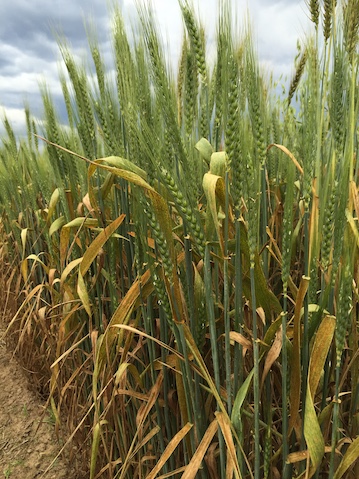
There are three rust diseases that afflict wheat:
- stripe rust, caused by Puccinia striiformis f. sp. tritici – abbreviated to Pst;
- leaf rust, caused by Puccinia triticina; and
- stem rust, caused by Puccinia graminis f. sp. tritici – abbreviated to Pgt.
Both stem rustand leaf rusthave been present in Australia since at least the time that Europeans arrived, and possibly before then on native grass species. Stripe rust, on the other hand, was first detected in Australia in 1979.
Variants exist within each of these three rust pathogens, known as pathotypes (also called strains or races). These pathotypes have arisen locally via processes that include random genetic mutation. On occasion, new pathotypes have been introduced into Australia from overseas.
While resistance breeding has been effective in dealing with new pathotypes that arose locally, this approach proved less effective with pathotype incursions of exotic origin.
For example, the last incursions of stem rust occurred in 1969 when two new pathotypes appeared, seemingly carried here on high-altitude winds from central Africa. Since the mid-1970s, however, stem rust of wheat has been very well controlled by genetic resistance. Key to this success was breeders’ ability to focus on incorporating effective stem rust resistance in local cultivars in the absence of exotic isolates finding their way into Australia.
 Stripe rust on wheat. Photo: Robert Park
Stripe rust on wheat. Photo: Robert Park
Improving the genetic basis of resistance to stem rustin the absence of exotic incursions has resulted in a huge reduction in the incidence of this damaging pathogen, in turn reducing its evolutionary potential and extending the ‘use-by date’ on resistance genes.
Stem rustis now hard to find in Australian wheat crops. In fact, it was not detected in any Australian wheat crop in 2021.
In contrast to stem rust, we have detected six incursions of exotic isolates of leaf rust and four of stripe rust, all of which have affected rust resistance pre-breeding and breeding.
The most obvious of these impacts in the past 20 years relate to stripe rust. Extensive epidemics of stripe rust have occurred following incursions in 1979, 2002, 2017 and 2018. The 2017 and 2018 incursions are responsible for the stripe rust seen in eastern Australia in 2020 and 2021.
Researchers within the GRDC-investment in the Australian Cereal Rust Control Program maintain strong international links with scientists engaged in researching new and emerging cereal rust threats.
This has allowed us to send Australian cereal germplasm overseas for testing against the most important rust threats in order to increase our preparedness should they manage to find their way here. These threats include several African pathotypes of stem rust (such as Ug99) and the true stripe rust pathogen of barley.
Understanding the rust pathotypes prevailing across Australia and the risk posed by new and emerging rust threats around the world is fundamental to the effective use of genetic resistance to protect cereal crops.
Should you find any rust in a cereal crop, please forward freshly collected rust samples – in paper only – to the Australian Cereal Rust Survey, University of Sydney, Australian Rust Survey, Reply Paid 88076, Narellan, NSW, 2567.
More information: Robert Park, robert.park@sydney.edu.au; Australian Cereal Rust Survey 2021 Sample Map - Google My Maps; The Cereal Rust Lab Cereal Rust Reports; NVT Disease Ratings.

























































